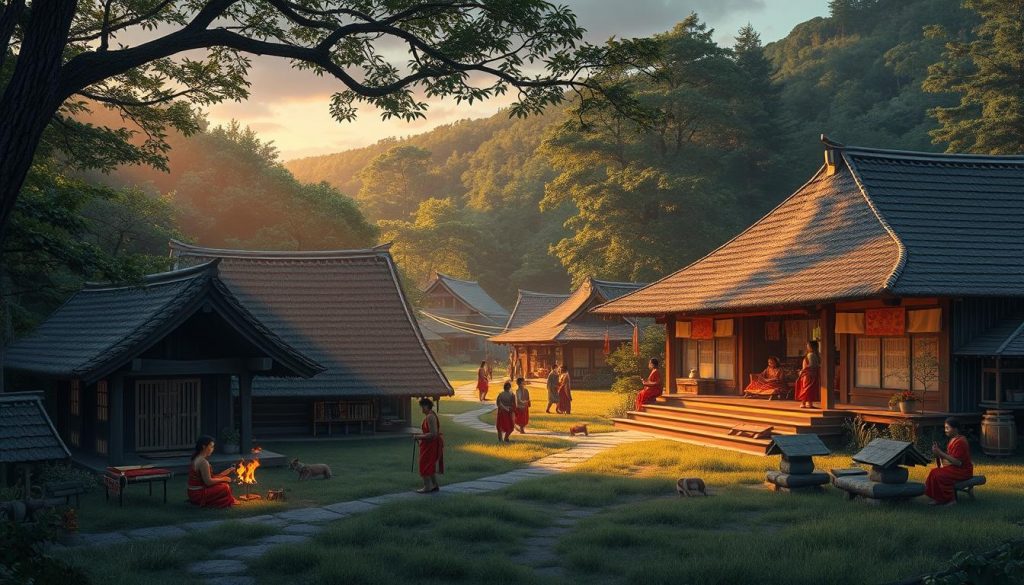Reviving the Ainu Culture in Japan
The Ainu culture is a key part of Japan’s rich heritage. It has been suppressed for years but is now experiencing a cultural revival. This revival is not just a look back at the past. It’s a vibrant reconnection that highlights the Ainu’s unique role in Japan’s culture.
Anúncios
Both government efforts and community movements are working together. They aim to bring the Ainu culture back to its rightful place. This is helping to deepen the appreciation for the diverse identities that make up modern Japan.
Understanding the Ainu Culture
Ainu culture is a rich mix of indigenous culture that’s key to Japan’s heritage. The Ainu live mainly in Hokkaido and have their own Ainu customs and language. They live in harmony with nature, showing respect in their daily lives and community.
Their belief in animism is a big part of Ainu traditions. They think spirits are in all living things and objects. This belief shapes their rituals and life, connecting them deeply to the environment. Their stories tell of a strong bond with nature, showing its importance in their survival and identity.
Looking at the historical context of Ainu culture helps us see how it has changed. It’s important to keep these customs alive, especially with the influence of globalization. The Ainu’s ability to adapt shows their strength, keeping their traditions alive for future generations.
Anúncios
| Aspect | Description |
|---|---|
| Ainu Language | A unique language with no close relatives, rich in oral tradition. |
| Rituals | Includes bear ceremonies and rituals honoring deceased ancestors. |
| Art Forms | Notable for intricate embroidery, traditional clothing, and wood carvings. |
| Folklore | Stories often incorporate themes of nature, spirituality, and morality. |
| Community Living | Strong emphasis on family and shared responsibilities among community members. |
The Importance of Cultural Preservation
Cultural preservation is key to protecting the Ainu identity in the face of modernization. As the world changes, indigenous cultures like the Ainu are at risk of disappearing. By saving their heritage, we ensure their history, traditions, and values live on for generations to come.
Preserving Ainu traditions is crucial. They give us a glimpse into their distinct way of life, adding to Japan’s cultural story. By keeping these customs alive, the Ainu show their strength and resilience.
Community efforts are underway to save Ainu culture. They focus on stories and traditional crafts. These efforts not only keep Ainu identity alive but also add to Japan’s rich heritage. They help people from all backgrounds appreciate diversity and shared traditions.
Government Initiatives to Revive Ainu Culture
The revival of Ainu culture in Japan is getting a boost from government efforts. In 2019, the Japanese government passed the Ainu Promotion Act. This act is a big step towards recognizing the Ainu as an indigenous people. It helps support education, cultural activities, and economic growth for Ainu communities.
The Ainu Museum in Hokkaido is a key part of these efforts. It’s a place where Ainu culture is celebrated through exhibits. Workshops and events are held to engage both Ainu people and the public.
These government actions are a major step forward for Ainu rights and culture. By investing in preservation and education, the Japanese society is learning more about Ainu culture.
| Year | Initiative | Description |
|---|---|---|
| 2019 | Ainu Promotion Act | Recognizes Ainu as indigenous, supports education and cultural activities. |
| 2020 | Ainu Museum Opening | A hub for cultural education and heritage preservation. |
| 2021 | Community Workshops | Events to engage both Ainu and the public in cultural practices. |
Grassroots Movements Promoting Ainu Culture
Grassroots efforts are key in bringing back Ainu culture. These programs focus on saving the language, traditional crafts, and stories. They help connect young people with their roots. Groups like the Ainu Association of Hokkaido boost pride and identity among Ainu youth.
Workshops and cultural events are crucial. They educate and unite people in their efforts to revive culture. Stories of success show the dedication of those working to preserve Ainu heritage. For more details, check out this article on cultural revival efforts.
Education and Ainu Culture
Education is key in bringing back Ainu culture. Schools are now teaching Ainu language, helping students love their heritage. Programs focused on Ainu language and history inspire young people to connect with their roots.
Many schools are adding cultural programs that show Ainu traditions. This helps students understand their identity through fun activities. Workshops on traditional crafts give students a chance to learn and feel proud of their heritage.
Also, “Education for Cultural Awareness” shows how important indigenous studies are. Schools with these programs have more cultural awareness. This leads to respect and love for Ainu culture.
Through these efforts, the connection to Ainu identity gets stronger. This ensures the culture lives on for future generations. Community support is vital, making education a shared goal for everyone.
The Role of Tourism in Ainu Cultural Revival
Ainu tourism is key to bringing back Ainu culture. More people want to see indigenous heritage through cultural tourism. This lets the Ainu share their traditions through performances and workshops.
This tourism model is all about being sustainable. It makes sure the benefits from visitors help the Ainu people. It aims to reduce harm to the environment and improve community life. Visitors can truly experience Ainu culture at places like Ainu Village and cultural festivals.
Being part of tourism helps the Ainu economically. Local artists and performers earn money and get noticed. Stories of successful tourism projects show how it can grow, respecting culture and boosting the economy.

| Aspect | Details |
|---|---|
| Ainu Tourism | Focus on cultural experiences and indigenous heritage. |
| Cultural Tourism | Highlights traditional performances and craft workshops. |
| Sustainable Practices | Promotes responsible tourism and community benefits. |
| Economic Empowerment | Generates income for local artisans and performers. |
Ainu Cuisine: A Taste of Tradition
Ainu cuisine is a rich food culture that shows the Ainu people’s deep connection with nature. It uses local ingredients that change with the seasons. This highlights the unique culinary heritage of the Ainu.
“Ruibe” is a dish made from raw fish, showing the Ainu’s skill in making traditional foods. It’s not just food; it’s a celebration of their culture. Wild mushrooms and herbs add flavor to meals, showing respect for the environment.
“Revitalizing Ainu cuisine not only preserves cultural identity but also introduces valuable flavors to a broader audience.”
Now, there are efforts to share Ainu foods at cultural events and restaurants. These efforts help spread the word about the Ainu’s unique cooking ways. By trying Ainu cuisine, people learn about the rich history and stories behind each dish.
- Ruibe – raw fish delicacy
- Wild Game – hunted meats prepared traditionally
- Foraged Mushrooms – seasonal ingredients that enhance flavor
Ainu cuisine reminds us of the strong bond between culture and food. It encourages everyone to discover flavors and traditions shaped by history. This way, Ainu culinary practices can continue to delight future generations.
Modern Expression of Ainu Culture
The modern Ainu culture is a mix of old traditions and new ideas. Ainu artists are making their heritage come alive through art forms. They use everything from painting and sculpture to digital art, making pieces that speak to people everywhere.
Festivals and shows are key in sharing this cultural expression. At events like art fairs and music festivals, Ainu artists show off their talents. They blend modernization with old traditions, telling stories that are both unique and universal.
Ainu artists are part of a bigger conversation about culture today. They keep their culture alive by being creative and open to new ideas. This shows how important it is to keep our stories alive through art in today’s world.
| Art Form | Description | Notable Artist |
|---|---|---|
| Traditional Craft | Uses natural materials for handmade items, showing off heritage skills. | Atsuko Kurokawa |
| Contemporary Painting | Mixes Ainu themes with modern styles and techniques. | Kojiro Iizuka |
| Performance Art | Brings traditional dances and songs into today’s world, telling Ainu stories. | Haruka Tsubaki |
| Digital Arts | Uses tech to make interactive art that reaches many people. | Sumi Yamato |
The Future of Ainu Culture
The future of Ainu culture looks bright, thanks to its resilience and community’s hard work. More people are starting to appreciate Ainu traditions, leading to a lively revival. Programs aimed at passing down traditions to younger generations are key, helping them connect with their heritage.
Efforts to preserve traditions are crucial. They help the Ainu keep their history alive while making it relevant today. This way, the culture grows and stays true to itself.
- Community workshops focused on traditional arts and crafts
- Language revitalization programs to teach Ainu languages
- Partnerships with educational institutions to promote Ainu studies
The next generation is ready to lead, blending modern touches with their roots. This mix creates a vibrant identity that speaks to both locals and the world.

Conclusion
The Ainu cultural revival in Japan shows the lasting power of indigenous identity. It highlights the rich heritage of the Ainu people. Thanks to government support, grassroots efforts, and education, there’s a growing recognition of Ainu culture.
This shift not only preserves traditions but also boosts Ainu pride. It’s a positive change for the communities involved.
As Ainu culture evolves, it brings new opportunities for the future. This cultural exchange adds depth to Japan’s heritage. It makes room for Ainu customs, music, and art in today’s world.
This ensures the Ainu legacy continues. To learn more about the impact of preserving heritage on Ainu culture, visit Ainu culture overview. The revival of Ainu identity is a lesson for us all. It teaches us about the value of cultural appreciation in creating a harmonious society.
